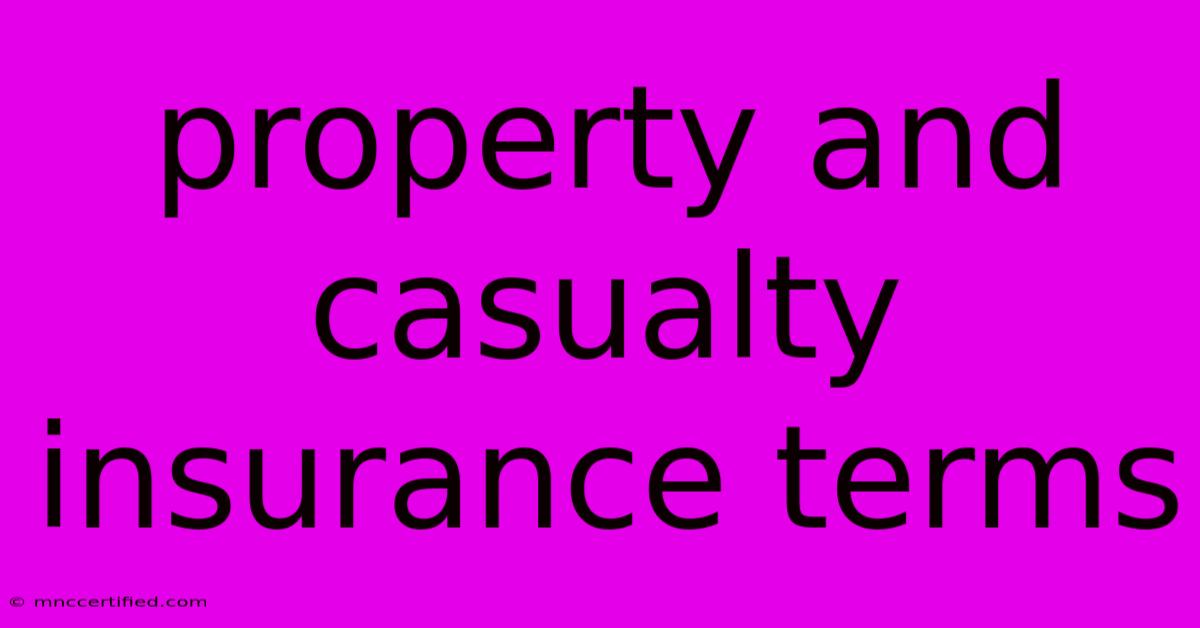Property And Casualty Insurance Terms

Table of Contents
Demystifying Property & Casualty Insurance Terms: A Comprehensive Guide
Property and casualty (P&C) insurance is a cornerstone of financial security, protecting individuals and businesses from unexpected losses. However, navigating the complex world of P&C insurance terms can be daunting. This comprehensive guide aims to demystify key definitions, helping you understand your coverage and make informed decisions.
Understanding the Basics
Property & Casualty Insurance: This umbrella term encompasses insurance policies that protect against financial losses arising from damage to property or liability arising from injuries or damages caused by the insured.
Insurer: The insurance company that provides coverage and pays claims.
Policyholder: The individual or entity who owns the insurance policy.
Premium: The regular payment made by the policyholder to the insurer for coverage.
Deductible: The fixed amount the policyholder must pay out-of-pocket before the insurer starts covering losses.
Coverage: The specific risks and situations covered by the insurance policy.
Claim: A request for compensation from the insurer for a covered loss.
Policy Period: The duration for which the insurance policy is in effect.
Exclusions: Specific events or circumstances that are not covered by the policy.
Key Terms in Property Insurance
Property Insurance: This covers losses to real estate and personal property from perils like fire, theft, and natural disasters.
Dwelling Coverage: Protects the physical structure of your home.
Personal Property Coverage: Covers your belongings within your home, such as furniture, electronics, and clothing.
Liability Coverage: Provides financial protection if you are held liable for injuries or property damage caused to others on your property.
Replacement Cost Coverage: Pays for the full cost to replace damaged property with new, similar items, regardless of depreciation.
Actual Cash Value (ACV): Pays for the cost of damaged property minus depreciation.
Peril: A specific event that can cause a loss, such as a fire or earthquake.
Hazard: A condition that increases the likelihood or severity of a loss, like a leaky roof or faulty wiring.
Key Terms in Casualty Insurance
Liability Insurance: This protects you from financial losses stemming from legal claims arising from negligence or accidents that injure others or damage their property.
Bodily Injury Liability: Covers medical expenses, lost wages, and pain and suffering for injuries caused to others.
Property Damage Liability: Covers damages to another person's property.
Uninsured/Underinsured Motorist Coverage: Protects you in the event of an accident caused by a driver without insurance or insufficient coverage.
Medical Payments Coverage: Pays for medical expenses for you and your passengers, regardless of fault, in case of an accident.
Personal Injury Protection (PIP): Covers your own medical expenses and lost wages after an accident, regardless of fault.
Navigating the Terms
Understanding these terms is crucial for making informed decisions about your insurance needs. When reviewing a policy, pay close attention to:
- Coverage limits: The maximum amount the insurer will pay for a claim.
- Exclusions: Specific events or circumstances that are not covered.
- Deductibles: The amount you will pay out-of-pocket before the insurer covers a loss.
- Premiums: The cost of the insurance policy.
Remember, consulting with a qualified insurance agent can provide valuable guidance on choosing the right P&C coverage for your unique circumstances.
By understanding these fundamental terms, you can better protect yourself and your assets from unforeseen events. Armed with this knowledge, you can confidently navigate the world of property and casualty insurance, ensuring peace of mind and financial security.

Thank you for visiting our website wich cover about Property And Casualty Insurance Terms. We hope the information provided has been useful to you. Feel free to contact us if you have any questions or need further assistance. See you next time and dont miss to bookmark.
Featured Posts
-
Best Health Insurance For Ms Patients
Nov 10, 2024
-
Dental Insurance Missing Tooth Clause
Nov 10, 2024
-
Will Fiberglass Resin Bond To Plastic
Nov 10, 2024
-
Late Goal Sinks City In Brighton Defeat
Nov 10, 2024
-
Top Upsc Current Affairs October 28 November 3 2024
Nov 10, 2024